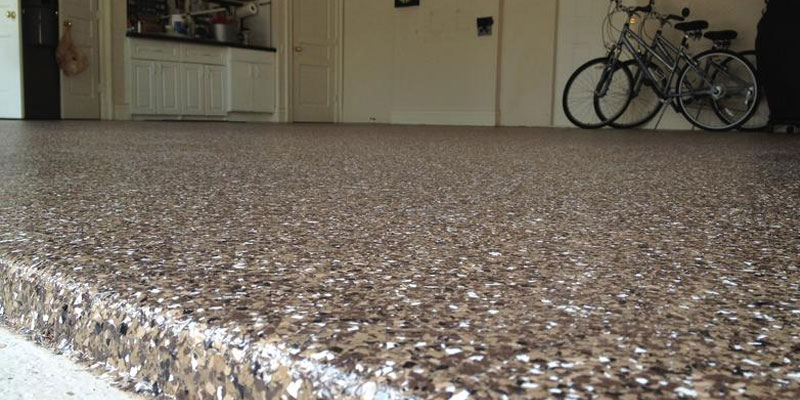There are many reasons why you may need an epoxy floor. If you’re planning to make some home improvements, chances are that at least one of your reasons for this is because it looks good and lasts a long time.
Most people want their floors to last as long as possible, both aesthetically and physically, which isn’t often the case with most common materials like wood or tile.
An epoxy floor can be easily applied over any surface. It’s quick-drying (2-4 hours), crack-resistant, stain-proof, chemical resistant, temperature proof (from -60 degrees Fahrenheit to 300 degrees Fahrenheit), and incredibly durable. It also gives off no toxic fumes during installation or use, so it’s safe enough for your home.
What is Epoxy?
Epoxy is a two-part resin system that, when mixed together, creates a hard and durable surface. This surface can be used in a variety of applications but is most commonly seen as a floor coating. These floors are great for garages, utility rooms, workshops, warehouses, and home applications.
The two parts are the base coat and the hardener. The base coat is mixed with an activator or any other solvent so that it can be applied to a surface. After application, the activator is spread over the floor to begin the chemical reaction. Once this reaction has started, it cannot be stopped, which makes working quickly very important when applying epoxy floors.
Once this first layer is spread out with an applicator roller or brush, it must be left for about 15-20 minutes until tacky but not sticky before applying another thinned coat of epoxy on top of it.
The actual thickness of the epoxy will vary based on personal preference and intended use. For instance, in a garage or workshop, you’ll want it thick enough to protect against damage like gas spills, oil leaks, and other automotive fluids. If your flooring is going in an area where there’s little traffic, then very thin coats are sufficient enough for protection without compromising looks too much. Without adequate coverage, these areas may look dirty or lackluster after only a few months when all that was needed was more paint.
Types of Epoxy Coatings
There are three types of epoxy coating available for purchase. The purpose and thickness of an epoxy coating will vary depending on what is required.
The first type is called a primer coat which is applied to surfaces that aren’t concrete or porous before any paint or epoxy flooring is used. This helps the top layer adhere better to the surface, increase its durability and longevity, and give it a nice, even finish without lumps or bumps. Primer coats are usually thinned with solvent so that they spread farther but still offer enough coverage for intense color or high gloss shine.
The second type is called tinted sealer coats. They’re generally used as a second layer but can be used by themselves if the desired color is achieved. The amount of pigment added to them will determine how dark they are, so if you need an opaque color, you’ll have to buy it with pigments already mixed in. These are usually ideal for utility rooms that aren’t exposed to large amounts of damage or spills.
The third type is called urethane top coats which are the most common types of coating available today. They’re sold in both water-based and solvent-based forms depending on where they’re being applied, whether there’s adequate ventilation, their overall durability needs, etc. Generally speaking, though, water-based coatings are less toxic and safer to use at home or around people. Urethane topcoats come in a variety of sheens, including matte, satin, semi-gloss, and high gloss, and can be applied over other coatings like epoxy or concrete paint without any problems.
How Thick Should an Epoxy Floor Be?
The thickness of an epoxy floor coating will vary depending on the type you use. However, a general guideline for primer coats would be to apply them at a thickness of 1-4 mils (1 mil = 0.001 inches). For tinted sealers or urethane topcoats, it’s best to apply them at a thickness of 4-8 mils for the best results.
Keep in mind that these are just rough guidelines, and certain factors can affect the actual thickness of your epoxy floor, including proper surface preparation, weather conditions, humidity levels, how many coats are applied, and overlapping each coat.
Understanding Epoxy Thickness Levels
When it comes to epoxy flooring, there are three main thickness levels that you’ll need to understand: broadcast, trowel, and flood.
Broadcast epoxy is the thinnest at around 1/8th of an inch thick and is usually used for small areas or in conjunction with other coatings like paint or concrete sealers. It can be applied using a squeegee, roller, or brush and can be tinted to any color you want.
Trowel epoxy is about 1/4th of an inch thick and is used for medium-duty applications. It’s best for areas that see a lot of traffic or wear and tear and should be applied with a trowel to ensure proper coverage and thickness.
Flood epoxy is the thickest at around 3/8th of an inch and is used for the most durable applications. It can be applied over other coatings like concrete paint or epoxy and is perfect for high-traffic areas or floors that are regularly exposed to spills, chemicals, or other liquids.
Final Thoughts
When it comes to the thickness of epoxy flooring, it’s important to remember that there is no one-size-fits-all solution. The amount you apply will depend on the type of epoxy you’re using, where it’s being applied, and what its intended purpose is. However, following these general guidelines should give you a good starting point for deciding how thick your epoxy floor should be.
For more information on how to determine the best thickness for your epoxy coatings and concrete stains, contact us today!

